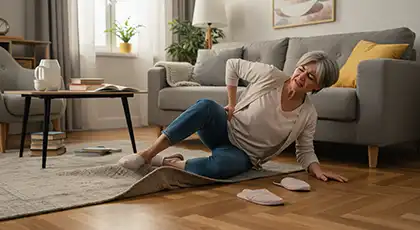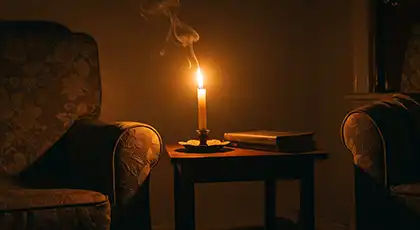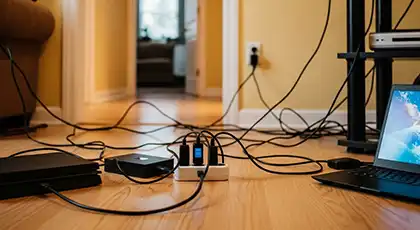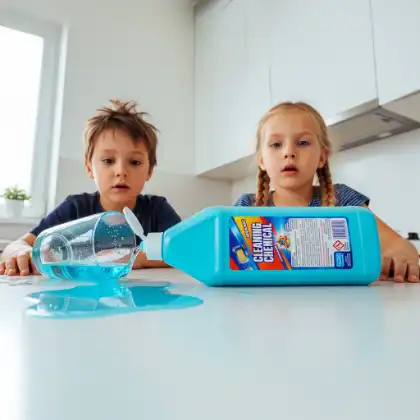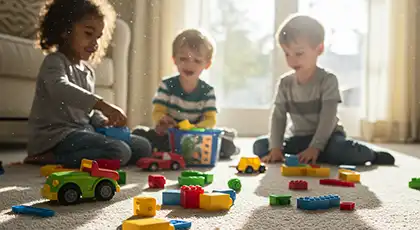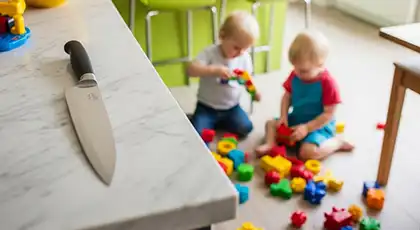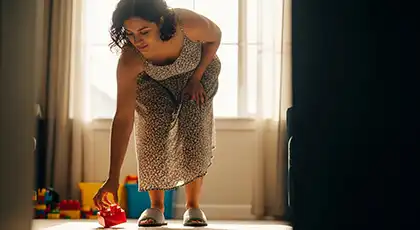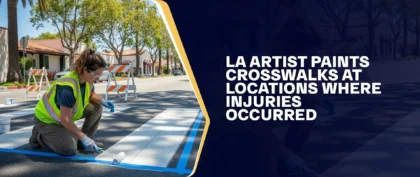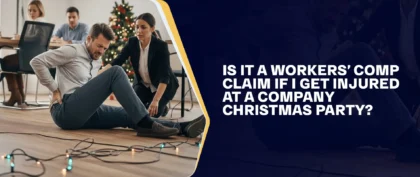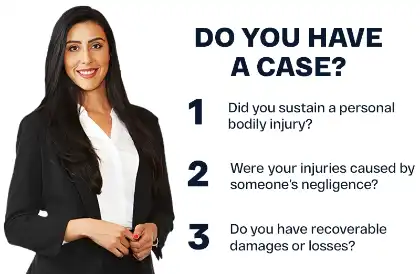TL;DR: Falls, fires, poisoning, and hidden hazards cause many preventable home injuries each year. If the accident happened because of a landlord, contractor, or defective product, you may be able to file a personal injury claim. Arash Law provides free case reviews and only charges attorney fees if compensation is recovered.
Table of Contents
Many people see their homes as safe spaces, but thousands of serious injuries happen indoors every year due to preventable hazards. In the United States, some of the most common dangers include:
- Falls
- Fires and burns
- Poisoning
- Electrical hazards
- Choking and strangulation
- Drowning
- Sharp objects
- Hidden risks like poor air quality or furniture tip-overs
Small changes like clearing walkways, securing cords, improving lighting, and storing hazardous items properly can significantly reduce the risk of injury.
In California, individuals injured due to unsafe conditions in rental homes, someone else’s property, or from defective products may be able to file legal claims involving:
- Negligent landlords or property owners.
- Unsafe repairs by contractors or service providers.
- Dangerous or defective appliances.
- Construction or design defects.
- Liability and insurance claims.
Our injury attorneys evaluate each case and help injured clients understand their legal options under California law.
Types Of Accident Risks Found Indoors
Most accidents at home happen because of preventable conditions or human error. While not every risk can be eliminated, being aware and prepared helps lower the chance of serious injuries.
According to the National Safety Council:
- In 2023, 62 million Americans sought medical care for nonfatal injuries. That’s about 1 in 5 people.
- That same year, there were 222,698 preventable deaths nationwide.
- Compared to 2022, preventable deaths dropped slightly by 1.9%.
- However, long-term trends show a sharp rise. In 1992, there were 86,777 preventable deaths. By 2023, that number had grown by 154% over 31 years.
Even with small year-to-year changes, the overall number of preventable deaths remains much higher than it was three decades ago.
Take a look at the following indoor risks that cause injuries and fatalities:
Slips, Trips, And Falls
Falls are one of the most common causes of indoor injuries, especially for adults over 65. According to the CDC, more than 1 in 4 older adults fall each year, but less than half seek medical care. Even minor slip-and-fall accidents can lead to:
- Hip fractures
- Head trauma
- Traumatic brain injuries
Common safety hazards include:
- Unsecured rugs or slippery floors.
- Poor lighting in stairways and hallways.
- Missing or unstable handrails and grab bars.
- Cluttered walkways or blocked paths.
- Footwear without proper grip or support.
- Wet floors, loose steps, or scattered objects.
- Health conditions like poor vision, muscle weakness, or medication side effects.
Even small falls can cause catastrophic injuries for anyone, but the risks grow as we age. Older adults may face more serious complications, such as fractures or head injuries, after a fall. Taking the following simple steps can help reduce these risks and support long-term independence:
- Replace dim bulbs with brighter ones in hallways and stairs.
- Install non-slip mats in bathrooms.
- Keep walkways clear.
- Add handrails and grab bars.
- Wear supportive footwear.
- Stay active with balance exercises.
- Get regular vision check-ups.
Fire Hazards
In 2023, a fire department responded to a fire every 23 seconds, according to the National Fire Protection Association (NFPA). Many home fires begin due to:
- Leaving candles unattended.
- Cooking without supervision.
- Placing heaters too close to flammable items like curtains or furniture.
- Overloading electrical outlets.
Kitchen fires are especially common, with deep frying being a leading cause of severe fire-related injuries.
You can prevent fire injuries by:
- Monitoring cooking and candle use.
- Turning pot handles inward.
- Installing and testing smoke alarms.
- Keeping heaters clear of curtains or furniture.
- Creating and practicing a fire escape plan.
A few precautions can make a big difference in protecting your home and loved ones from fire-related accidents.
To prevent burn injuries and scalds:
- Turn pot handles toward the back of the stove.
- Keep hot liquids away from the edges of counters or tables.
- Wear fitted clothing while cooking to prevent fabric from catching fire.
- Use oven mitts that fully cover your hands and wrists.
- Unplug heated appliances after use.
- Check bathwater temperature before getting in, especially for children and older adults.
- Keep children and pets out of the kitchen while cooking.
Even small burn injuries can be painful and may take time to heal. Taking these small steps helps create a safer home for everyone.
Electrical Hazards
Electricity helps power your home. However, it can also be dangerous when used or maintained recklessly. Faulty wiring, damaged cords, or unsafe practices can lead to electrocution accidents.
Here are common electrical risks to watch out for:
- Frayed or damaged cords.
- Overloaded outlets or power strips.
- DIY electrical work that isn’t up to code.
- Using appliances near water.
- Wet hands when handling plugs or switches
- Ignoring the manufacturer’s safety instructions.
How to prevent electrical accidents:
- Replace worn or frayed cords immediately.
- Avoid plugging too many devices into one outlet.
- Hire licensed professionals for electrical repairs and upgrades.
- Keep electrical devices away from sinks, tubs, and wet surfaces.
- Dry your hands before touching outlets or switches.
- Always follow the manufacturer’s safety guidelines when using appliances.
Being careful with electricity helps prevent fires, shocks, and other serious injuries.
Poisoning
In 2023, poisoning caused over 100,000 deaths in the United States. Men were nearly three times more likely to die from poisoning than women. While the numbers dropped slightly from the year before, poisoning deaths have increased sharply over the past 26 years.
Many everyday items can be harmful if used incorrectly or left within reach of children.
Here are some common poisoning risks at home:
- Cleaning products
- Prescription and over-the-counter medications
- Pesticides and insect killers
- Batteries
- Bleach and other disinfectants
- Paint and solvents
- Cosmetic soaps
- Detergent pods
How to prevent poisoning:
- Store chemicals, medicines, and hazardous items in locked cabinets or out of children’s reach.
- Keep products in their original, labeled containers to avoid confusion.
- Properly dispose of expired or unused medications and chemicals.
- Post the poison control number where it’s easy to find and save it in your phone.
- Teach children never to touch or taste unknown household items.
Taking simple precautions helps protect everyone in your home from accidental poisoning.
Carbon Monoxide Poisoning
Carbon monoxide (CO) is a deadly gas that can build up inside homes without any warning. It has no color, smell, or taste, making it very hard to detect without proper equipment. Every year, carbon monoxide poisoning leads to over 400 deaths and sends thousands more to emergency rooms in the U.S.
Early symptoms include:
- Headaches
- Dizziness
- Nausea
- Fatigue
These signs often seem minor at first, which is why many people don’t realize they’re in danger until serious harm occurs.
These tips can help you protect your family:
- Install carbon monoxide detectors on every level of your home.
- Test detectors monthly and replace batteries as needed.
- Have gas appliances, furnaces, and heating systems inspected regularly.
- Never run generators, grills, or gas-powered tools inside the house or garage.
- Keep chimneys and vents clear so harmful gases can escape safely.
Simple prevention steps and working detectors are the best way to protect your family from carbon monoxide exposure.
Choking And Strangulation Hazards
Choking and strangulation can happen quickly and quietly at home. Small children are especially at risk because of their smaller airways and natural curiosity. However, these accidents can happen to anyone.
Common choking hazards:
- Small toy parts
- Hard or round foods
- Coins
- Paper clips and pen caps
- Buttons
- Rubber bands
- Jewelry
- Plastic bags
Common strangulation hazards:
- Window blind cords
- Loose bedding and pillows
- Clothing drawstrings
- Long necklaces
- Extension cords
- Cords from electronics
- Defective cribs or cribs with unsafe gaps or loose parts
Between 1990 and 2015, over 16,800 window blind-related injuries were reported among U.S. children under six. Most injuries involved cords, and over 80% of entanglements affected the neck.
How to prevent choking and strangulation:
- Cut food into small pieces, especially for young children or anyone with swallowing difficulties.
- Keep small objects and loose cords out of children’s reach.
- Secure or remove window blind cords.
- Choose toys appropriate for a child’s age.
- Follow safe sleep guidelines for babies, keeping cribs clear of soft items.
- Learn basic first aid, including choking rescue techniques like the Heimlich maneuver.
A few simple precautions can make your home much safer and help prevent these silent dangers.
Sharp Objects And Tools
Sharp tools are useful for cooking, cleaning, and fixing things around the house. However, when they’re left out or stored the wrong way, they can lead to serious injuries. Knives, peelers, razors, scissors, and broken glass can cause deep cuts or lacerations.
You can reduce the risk by making small changes, like:
- Store knives in locked drawers or knife blocks.
- Keep peelers, graters, and scissors in closed cabinets, away from children.
- Place razors and sharp personal items on high shelves.
- Lock away gardening tools and return them to storage after use.
- Safely dispose of broken glass or sharp trash using heavy-duty bags or containers.
A few simple storage habits can prevent painful and sometimes serious injuries caused by sharp household items.
Drowning
Drowning is one of the most tragic accidents that can happen at home, especially for young children. While it’s less common than other household injuries, it’s far more likely to be fatal.
- Drowning is the leading cause of death for children aged 1 to 4.
- Most of these tragedies happen in residential swimming pools.
- 75% of all drownings in infants under one year old occur in bathtubs.
You can prevent drowning by staying alert and limiting access to water.
Here are some other tips to keep in mind:
- Never leave children unattended in the bath, even for a moment.
- Keep toilet lids closed.
- Empty buckets, tubs, or other containers after use.
- Install self-latching gates and fences around pools.
- Use pool alarms or motion detectors to alert you if someone enters the water.
- Keep rescue gear like life rings or reaching poles nearby.
- Teach children water safety skills as early as possible.
Close supervision and simple safety steps can help prevent these heartbreaking accidents.
Overlooked Indoor Safety Risks
Many people think of fires, falls, or sharp objects when it comes to home injuries. Still, some risks are less obvious and often go unnoticed until someone gets hurt.
Here are some commonly overlooked risks and what you can do to prevent them:
- Furniture Tip-Overs
- Secure tall or heavy furniture to the wall with brackets.
- Avoid placing heavy items on top shelves.
- Pressure Cookers & Instant Pots
- Follow the manufacturer’s safety instructions.
- Check the lid lock, seal, and release valve before each use.
- Dishwasher Hazards
- Close the door immediately after loading or unloading.
- Keep children away while the dishwasher is open or running.
- Trampoline Injuries
- Limit jumping to one person at a time.
- Use safety nets and padding around the frame.
- Poisonous Plants
- Research plants before bringing them inside.
- Keep toxic plants unreachable for children and pets.
- Animal Bites & Scratches
- Supervise pets around young children.
- Teach kids gentle handling and respect for animals.
- Exercise Equipment
- Set up equipment in a clear, open area.
- Follow usage guidelines and store equipment safely when not in use.
Taking simple steps to manage these hidden risks can help make your home much safer.
Health Risks Inside The Home
Your home can affect your health in ways you might not always notice. From the air you breathe to daily habits, small issues can build up and impact your well-being.
- Poor Air Quality — Dust, mold, and chemicals can affect indoor air quality, leading to symptoms like headaches, fatigue, or breathing problems.
How to improve air quality:
- Open windows for at least 15 minutes daily to let fresh air in.
- Use air purifiers with carbon filters.
- Maintain humidity between 30% and 50% to reduce mold growth.
- Store chemicals outside or in well-ventilated areas.
- Choose natural cleaning products.
- Add houseplants like snake plants or pothos to help clean the air.
- Indoor Allergens — Pollen, pet dander, dust mites, and mold can trigger allergies and worsen respiratory issues.
How to reduce allergens:
- Vacuum often with a HEPA filter.
- Dust furniture regularly.
- Wash sheets and pillowcases weekly in hot water.
- Brush pets outside and keep them out of bedrooms.
- Use washable curtains and reduce clutter.
- Extreme Heat — High temperatures inside the home can lead to heat exhaustion or heat stroke.
How to stay safe:
- Use fans or air conditioning during hot days.
- Stay hydrated and drink water regularly.
- Wear light, breathable clothing.
- Avoid strenuous activities during peak heat hours.
- Stress at Home — Ongoing stress can affect your body, leading to muscle tension, headaches, and sleep problems.
How to reduce stress at home:
- Create a quiet space to relax.
- Practice deep breathing or stretching exercises.
- Take warm baths to relax muscles.
- Limit screen time for at least one hour daily.
- Use soft lighting and calming colors.
- Keep your living space clean and organized.
Technology And Modern Risks
New technology makes home life more convenient, but it also introduces new safety risks that many people don’t anticipate.
Here are some common technology-related dangers found in modern homes, and how to prevent them:
- Smartphone-Related Injuries — Using smartphones while walking or doing tasks can lead to falls, accidents, or strain on the neck, hands, and back.
To stay safe while using your phone, try these simple steps:
- Stay aware of your surroundings while using your phone.
- Set limits on screen time to avoid strain.
- Use phone stands or holders to reduce hand and neck fatigue.
- Take regular breaks from screens.
- Virtual Reality (VR) Headsets — VR headsets can cause people to trip over furniture, bump into objects, or experience motion sickness.
Before using VR headsets, take these precautions:
- Clear enough space before starting.
- Follow the manufacturer’s safety instructions.
- Take breaks to avoid eye strain or dizziness.
- E-Cigarettes and Vaping Devices — Vaping can lead to lung damage, and faulty devices have caused fires or e-cigarette explosions.
To reduce risks while using vaping devices:
- Buy devices from reputable sources.
- Avoid modifying or tampering with the device.
- Charge devices only with the charger provided.
- Store them safely and away from heat sources.
Simple Steps That Keep Your Home Accident-Free
Even with many hazards covered, a few extra safety habits can make your home safer.
Here are additional steps you can take:
- Use sturdy step stools or ladders instead of chairs when reaching high places.
- Secure rugs and mats with non-skid pads, especially near entryways.
- Check staircases regularly for loose handrails or worn carpeting.
- Keep emergency supplies like flashlights, batteries, and a first aid kit in an easy-to-find spot.
- Test smoke and carbon monoxide detectors monthly to ensure they work properly.
- Childproof cabinets and drawers that store sharp tools or hazardous materials.
- Anchor televisions and large appliances to prevent tip-overs.
- Review and update your emergency contact list, including local poison control.
Small habits like these add extra layers of protection to reduce the chance of accidents at home.
Common Questions About Indoor Dangers And Preventing Accidents At Home
Most people think of home as the safest place to be, but many serious injuries actually happen indoors. From faulty wiring to slippery tiles, everyday items can quickly turn hazardous. Below are some of the most common questions people ask when it comes to staying safe at home and preventing avoidable accidents.
What Should Be In Your First Aid Kits?
Having a first aid kit at home helps you respond quickly to minor injuries before professional help arrives. The American Red Cross recommends keeping one at home and in your car.
Essential items to have in your first-aid kit include:
- Adhesive bandages (various sizes)
- Sterile gauze pads and gauze rolls
- Adhesive tape
- Antiseptic wipes
- Antibiotic ointment
- Hydrogen peroxide
- Alcohol wipes
- Super glue (for minor cuts)
- Instant cold packs
- Elastic bandages (for sprains and strains)
- Non-latex gloves
- Tweezers
- Scissors
- Digital thermometer
- Cotton balls and swabs
- Burn cream or aloe gel
- Eye wash solution
- Emergency blanket
- CPR face shield or breathing barrier
- First aid instruction manual
For families with young children, elderly members, or anyone with medical conditions, consider adding extra items like:
- Child-safe medications
- Allergy medications (antihistamines)
- Pain relievers (acetaminophen, ibuprofen)
- Prescription medications (if needed)
- Medical information cards for family members
- Splints or finger splints
- Flashlight with extra batteries
Store your first aid kit somewhere easy to reach, and check it regularly to replace anything that has expired or is missing. A well-stocked kit can help you handle many minor emergencies at home.
Who’s Liable For Home Accidents In California?
If you or your family suffer injuries at home because of something that wasn’t your fault, these parties may be legally responsible:
- Product Manufacturers — If a product was designed or built dangerously.
- Product Distributors or Retailers — If they sold defective or unsafe products.
- Contractors And Repair Companies — If poor repairs or work created safety hazards.
- Electricians, Plumbers, or Service Technicians — If faulty installations or repairs caused the accident.
- Home Builders or Developers — If construction defects led to dangerous conditions.
- Previous Property Owners — If they sold the home without warning you of hidden hazards.
- Landlords or Property Managers (if you’re renting) — If they failed to maintain the property or ignored repair requests.
- Maintenance or Inspection Companies — If they missed hazards they were hired to spot or fix.
- Pest Control or Home Service Providers — If their work was left behind or led to dangerous conditions.
Depending on the situation, you may have the right to seek compensation from the party responsible for creating or failing to correct the danger.
When these accidents happen, you might wonder, “Do I need a personal injury lawyer?” Speaking with a lawyer for personal injury claims can help you understand your rights and options. If you’re already working with one, they may also provide free accident lawyer advice tailored to your situation.
What Are The Common Dangers People Encounter Indoors, And How Can They Prevent Accidents At Home?
Many believe their home is a haven. Yet, serious accidents frequently occur indoors due to common hazards such as falls, fires, poisoning, electrical issues, choking, drowning, sharp objects, and hidden risks.
To reduce the likelihood of injuries, individuals can take preventive measures like clearing walkways, securing loose cords, enhancing lighting, and properly storing dangerous items. In cases of accidents on rental properties or due to defective products, legal options may be available, including claims against landlords, contractors, or manufacturers.
Awareness and preparedness are key, as statistics show that in 2023, approximately 62 million Americans needed treatment for nonfatal injuries, highlighting the importance of safety at home.
How Arash Law’s Injury Lawyers Can Help
Even with safety steps in place, accidents at home sometimes happen because of issues outside your control. If a defective product, poor repairs, or someone else’s negligence caused an injury, you may have legal grounds to pursue a claim depending on the facts of your case.
At AK Law Firm, our personal injury attorneys are available to discuss your situation and review possible legal options. We investigate how the injury occurred, identify who may be responsible, and guide you through the legal process.
We handle cases on a contingency fee basis. You do not owe attorney fees unless we recover compensation for you. Case costs may still apply regardless of the outcome.
We handle a variety of injury cases, including those involving truck collisions, motorcycle crashes, and accidents involving Lyft or Uber. Our car accident lawyers are here to assist victims facing these situations. To speak with our legal team, call (888) 488-1391 or complete our “Do I Have A Case?” form to schedule a free initial case evaluation.

